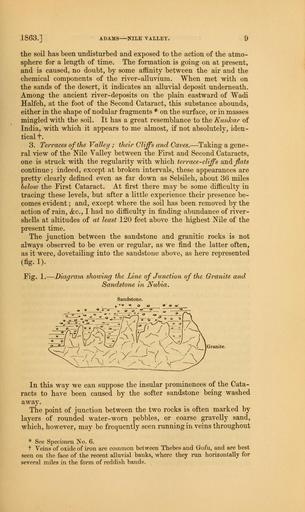MAKE A MEME
View Large Image

| View Original: | The_Quarterly_journal_of_the_Geological_Society_of_London_(12895221284).jpg (1226x2061) | |||
| Download: | Original | Medium | Small | Thumb |
| Courtesy of: | commons.wikimedia.org | More Like This | ||
| Keywords: The Quarterly journal of the Geological Society of London (12895221284).jpg 1863 <br> ADAMS NILE VALLEY <br> D <br> the soil has been undisturbed and exposed to the action of the atmo- <br> sphere for a length of time The formation is going on at present <br> and is caused no doubt by some affinity between the air and the <br> chemical components of the river- alluvium When met with on <br> the sands of the desert it indicates an alluvial deposit underneath <br> Among the ancient river- deposits on the plain eastward of Wadi <br> Halfeh at the foot of the Second Cataract this substance abounds <br> either in the shape of nodular fragments on the surface or in masses <br> mingled with the soil It has a great resemblance to the Kunkar of <br> India with which it appears to me almost if not absolutely iden- <br> tical f <br> 3 Terraces of the Valley ; their Cliffs and Caves ” Taking a gene- <br> ral view of the Nile Valley between the First and Second Cataracts <br> one is struck with the regularity with which terrace-cliffs and flats <br> continue ; indeed except at broken intervals these appearances are <br> pretty clearly denned even as far down as Selsileh about 36 miles <br> below the First Cataract At first there may be some difficulty in <br> tracing these levels but after a little experience their presence be- <br> comes evident ; and except where the soil has been removed by the <br> action of rain fcc I had no difficulty in finding abundance of river- <br> shells at altitudes of at least 120 feet above the highest Nile of the <br> present time <br> The junction between the sandstone and granitic rocks is not <br> always observed to be even or regular as we find the latter often <br> as it were dovetailing into the sandstone above as here represented <br> I - <br> Fig 1 ” Diagram showing the Line of Junction of the Granite and <br> Sandstone in Nubia <br> Sandstone <br> ¢ ¢ » o o <br> Granite <br> In this way Ave can suppose the insular prominences of the Cata- <br> racts to have been caused by the softer sandstone being washed <br> away <br> The point of junction between the two rocks is often marked by <br> layers of rounded water-worn pebbles or coarse gravelly sand <br> which however may be frequently seen running in veins throughout <br> See Specimen No 6 <br> t Veins of oxide of iron are common between Thebes and Gofu and are best <br> seen on the face of the recent alluvial banks where they run horizontally for <br> several miles in the form of reddish bands 36089230 111261 51125 Page 9 Text v 20 http //www biodiversitylibrary org/page/36089230 1864 Geological Society of London Biodiversity Heritage Library The Quarterly journal of the Geological Society of London v 20 1864 Geology Periodicals Smithsonian Libraries bhl page 36089230 dc identifier http //biodiversitylibrary org/page/36089230 smithsonian libraries Information field Flickr posted date ISOdate 2014-03-03 Check categories 2015 August 26 CC-BY-2 0 BioDivLibrary https //flickr com/photos/61021753 N02/12895221284 2015-08-26 16 56 15 cc-by-2 0 PD-old-70-1923 The Quarterly journal of the Geological Society of London 1864 Photos uploaded from Flickr by Fæ using a script | ||||